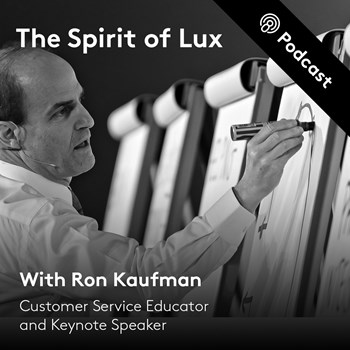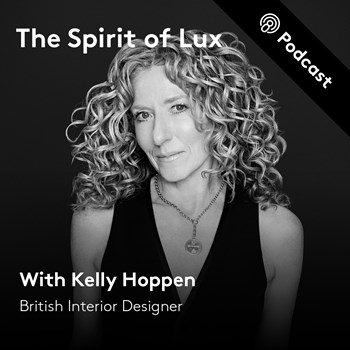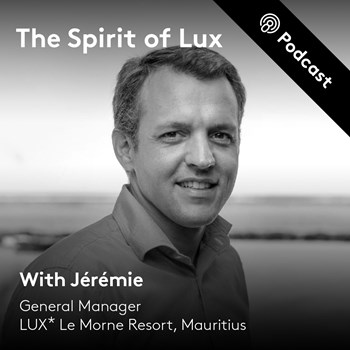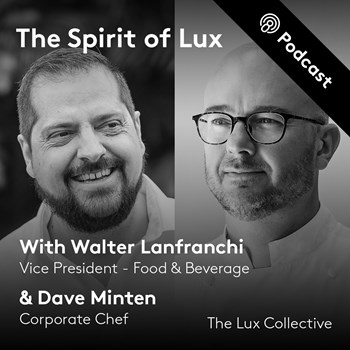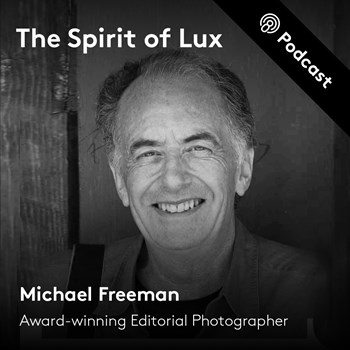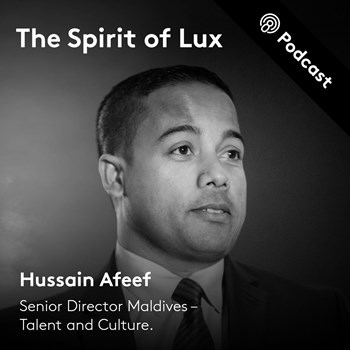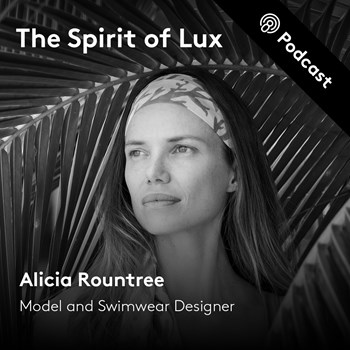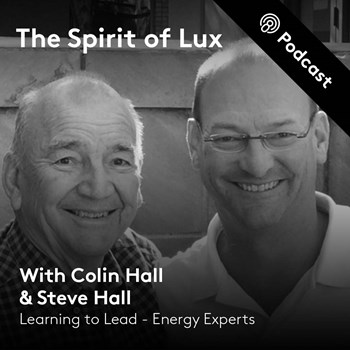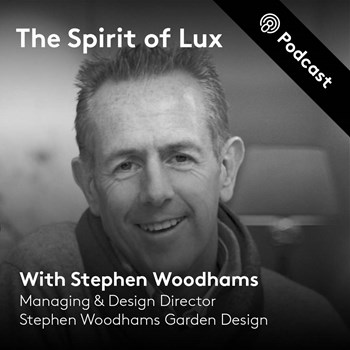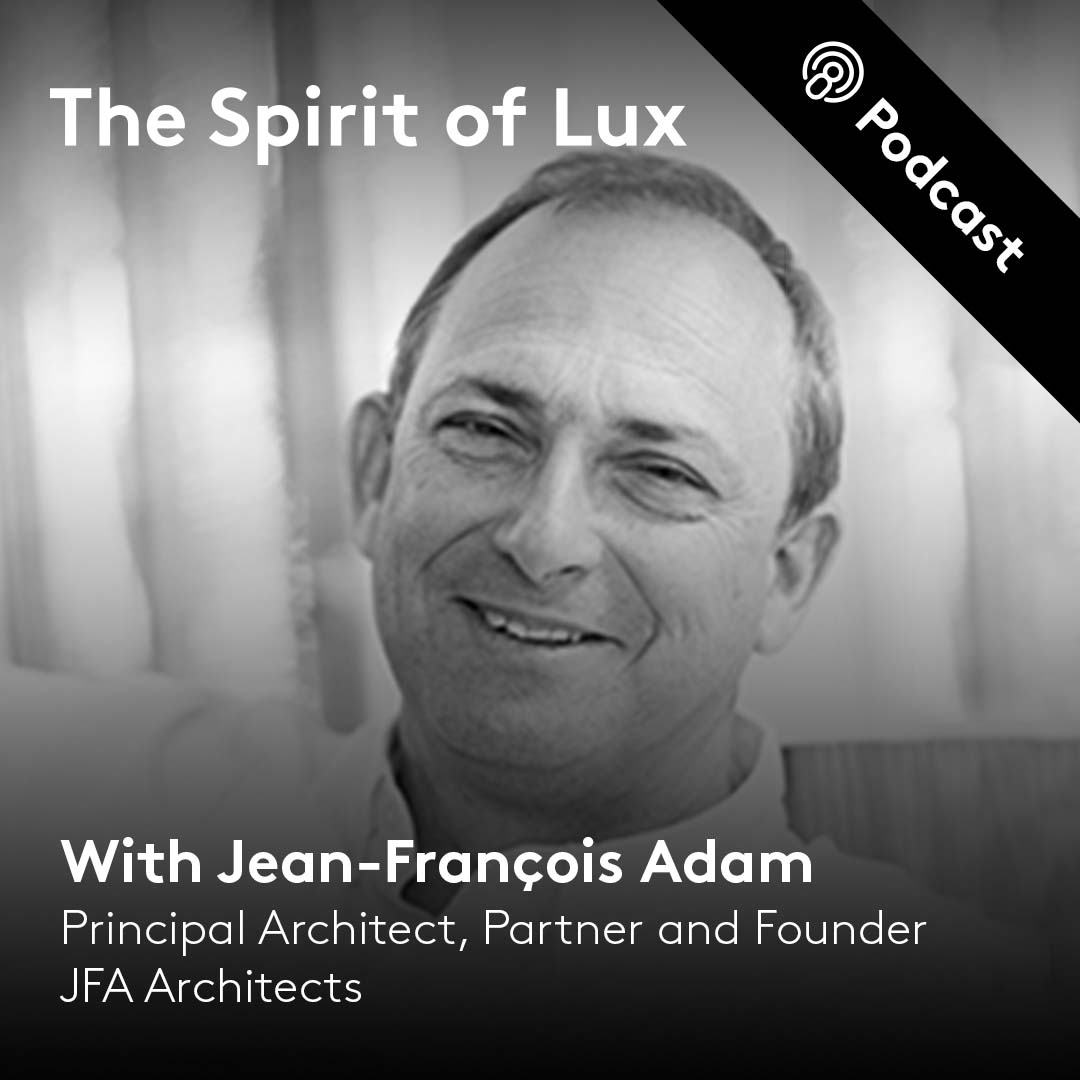 The 12th episode reunites Paul with Mauritian architect Jean-François Adam, the man behind the groundbreaking design of the very complex LUX* Grand Baie. Together they discuss what inspired Jean-François, whose childhood was spent on the very beach on which the hotel is, the complexities of building such a grand structure, of turning constraint into potential, and the importance of having a strong vision and the team spirit to carry it through.
The 12th episode reunites Paul with Mauritian architect Jean-François Adam, the man behind the groundbreaking design of the very complex LUX* Grand Baie. Together they discuss what inspired Jean-François, whose childhood was spent on the very beach on which the hotel is, the complexities of building such a grand structure, of turning constraint into potential, and the importance of having a strong vision and the team spirit to carry it through.
A Conversation with Jean-François Adam: Principal Architect, Partner and Founder of JFA Architects
Paul Jones: I am Paul Jones and you are listening to The Spirit of Lux.
Jean-François Adam: I think that architecture cannot be architecture without urban design -- urbanism.
Jean-François Adam: You get this wow effect of the sea, the blue sea, the beach, the reflective part, you can see the rooms on one side, you can see the Beach Rouge on your left side, and then you understand where you are and you obviously conclude within your heart that you will have an amazing stay in this beautiful place.
Jean-François Adam: I think planning is very important. And planning comes from my urban design background, where you’ve got to get it right. Sometimes you got to go really back to the basics of what architecture and planning is, before finally conclude on such a thing.
Paul Jones: Greetings and welcome from the magical island of Mauritius in the southern Indian Ocean. Today, we are celebrating the opening of the magnificent LUX* Grand Baie. What a magical island and what a magnificent hotel it is. Welcome to The Spirit of Lux. Today, we have not only than the architect who was responsible for the magnificent architecture that we see here at LUX* Grand Baie. It's absolutely splendid. And it's come out of the ground in all its glory. Jean-François Adam, we've known each other for more than 20 years. I think the first time we met, you were working on our hotel in the east coast of Mauritius, the Touessrok when you were together with Mico Giraud, who was one of the pioneer architects of Mauritius, if not the pioneer architect, and you came out of his practice to set up your own practice. I also remember, I think it was you, designed our house in Trou d’Eau Douce next to the Touessrok. And that also stands out as a great memory for me. But what is more important is this gorgeous hotel that you have created, Jean-François. So, please introduce yourself for the listeners. And then we can get stuck into how you went about creating the magnificent LUX* Grand Baie. Over to you, Jean-François.
Jean-François Adam: Thank you very much, Paul, for welcoming me on The Spirit of Lux. And it's an honorr to be sharing these ideas with you. And yes, we did meet in 1992, I think, and Sol Kerzner and the team, for the first time we worked together on this project, which was then also a very interesting one. I was working under Mico. I was a lead architect. I was only 33 or 32 years old at that time, I would say very young. I did enjoy because he got me through to the real world as your structure of Sun International was there with us through Dean Murphy, Mirage, and all these boys who taught me what the real world was. And working under Mico was a privilege also because if I'm here today is just because I had a great chance of meeting some amazing people in my life, which was Mico Giraud, which was Mr. Paul Jones, amongst others. Actually I did help also on your design of your house at that time, but I wasn't responsible for the architecture of it. Mico was all behind it, but he had my hands ready for help in any case, you know.
Paul Jones: Right. So, tell us about LUX* Grand Baie, Jean-François.
Jean-François Adam: LUX* Grand Baie, Paul, came I don't know how many years after. We spent almost 15 years with Mico, and I believe that I was at the right school and that got me going through the years because architecture is a difficult world, is a difficult trade, is a difficult profession. I would say lots of people don't even look at it as a profession. I think it's a very complicated profession. You've got to be well geared to understand all the parameters of architecture. And only experience through years can get you to these good results. Yeah, some famous architect did mention once that architecture is an old man's profession, and I think I'm an old man today. So, I've learned a lot. After those 15 years with Mico, I've opened my own practice, and started doing what I like to do. We had good practice with Mico in the hospitality industry, because we kind of did most of the hotels on the island. So, we were there to understand the mechanism of it. And under my own practice, I started by the Beau Rivage Hotel, which is now the LUX* Belle Mare, which has still not been actually renovated on the architectural side, I think you did some beautiful renovation with Kelly, which enhanced the structure a lot. And then we went amongst which was the Royal Palm at Marrakech, which is managed by Fairmont today, to finally and then LUX* Grand Baie, Paul.
Paul Jones: Right. Exactly. So, LUX* Grand Baie, how was this born? How was the baby born in your mind, Jean-François? How did you conceive of this magnificent masterpiece?
Jean-François Adam: Yes, Paul. Before answering your question, I might go back to the history. Because you called me for LUX*, to work on the Merville renovation, that was couple of years back. And you gave me this challenge of reviewing the whole structure. So, we did a first sketch proposal, keeping all the existing structures as is because they were built just next to the sea. And we weren't able to actually move it back because of the authorities’ guidelines and the 30-metre setbacks. We did try. But we could see that it wasn't ‘the’ project because the rooms were small, the ceiling heights were low, the corridors were restrictive, and we wanted to have something more. I can remember we wanted to have something with more grandeur there. And then we gave it another try with same form of concept. But we brought down the structures and rebuild on the same footprint, but with the real-size bedrooms and all the mechanism of the hotel with a kitchen underneath, rooms on the right, and blah, blah, blah, where we did add a sky walk crossing the road to some restaurant, even a nightclub behind, which was in the design brief at that time. And that brought a lot of hesitation. And then you finally decided to go to the Grand Gaube, and you gave me a go-ahead just a few months before the first contractors on-site came to demolish and we had to rush into the design of Grand Gaube, which we did in a few months' time. That was a great experience. It was a great, great gathering. We had a nice team. And as I always say, the success of the projects is really in its team. And when the team gets on well together, you can do extraordinary things, and it worked over the LUX* Grand Gaube, although we were very restricted by the existing structures there. But when we had open sheets of paper in front of the LUX* Grand Baie, we had to strike hard. And I knew the sites, I knew every kind of spot within it, and we had to get something grand there. And I think finally looking back at that, we successfully did, Paul.
Paul Jones: All right. And then, Jean-François, you went back to your childhood days in Grand Baie, where you were fishing from the rocks and then from the fishing you went to the pirogue. And then eventually, you graduated to sailing boats. And that you told us inspired your architecture for LUX* Grand Baie.
Jean-François Adam: Exactly, Paul. I am someone from Grand Baie. My mother's parents were staying in Pointe Canonnier and my father's parents were staying in Anse la Raie. And we were in Bain Boeuf since my very young age where we kind of shared the very old and rustic Grand Baie life. Obviously, we were attracted more towards the sea. I was into a lot of diving at this time, fishing, boats, and so on. And effectively, sailing boats just tried my mind and I kind of got obsessed by sailing boats. And I was sketching and drawing these sailing boats for some years all day long. And it's just came to my mind that there is a beautiful structural result in a sailing boat with only a thin mast stuck on a thick body, cutting the waves of the sea and taking good pressure wind from the side to get it to move ahead. I think all this is just amazing. And in Grand Baie, we had the Grand Baie Yacht Club. And as a youngster, I was going very often there seeing all these boats going in and out and the bay of Grand Baie, passing in front of Merville, the old name for LUX* Grand Baie, and all that got into my mind. And these sketches had to come out sometime to do something and be useful to me somehow, Paul.
Paul Jones: And you also wrote some poetry about it? Do you remember some of the words you used for the poetry that you put to this vision of yours with the sails?
Jean-François Adam: Yes, Paul. We did actually work on these four beautiful words, which are refinement, purity, elegance, and harmony. And obviously, you've got a kind of cascading effect on these four words. Refinement, I would define it at the successive layers of work through design, development, getting all the team to work together, backwards and forward, to get the right refinement in architecture. You just can't have a sketch proposal just built like that, you got to go through this design development, It's very, very important. And these are my keywords in my office. And refinement, obviously, bring us to purity, purity of design, because when you go through this refinement, you finally reach a form of purity. And this purity is hard work. You've got to go through it, and obviously ends up into elegance. The elegance is the result of this hard work. And you can feel the elegance when you walk in the building. You can feel the volumes where the refinements and so on. And to finally come with a harmony of such a project. I mean, what I did write was in French, they're trying to translate it through remembering what I did right. But the harmony, most and for all, is the unity of these first three words where people come back to use the structure of the hotel because LUX* Grand Baie is not only the architecture. It is the architecture, the interiors, the lighting, the landscaping. The people operating it take most of the time to get these four factors working together properly. And this is where the success of such a hotel lies.
Paul Jones: Absolutely. And what comes to mind, Jean-François, from my knowledge and experience is the volumes, as you said in the adjacencies. And the volumes that you've created are absolutely surprising because when you enter the hotel, you have quite a small portico that you actually walk through. And when you approach it, you got this beautiful mix of materials, which we'll come to a little later when I ask you about the choice of materials. But those materials strike this harmony, but the scale of it as you approach and you're approaching it on a slope going up, it seems small and intimate. And when you enter, that's when you get this volume. Now how did you ever envisage such a voluminous space for the lobby? How did that come about? And how did you achieve it?
Jean-François Adam: Paul, I think that architecture cannot be architecture without urban design-- urbanism. The feeling of this whole hotel comes somehow, starts by the street experience which was just existing there. We had to play with this road, which was there. It's quite a popular road. It's going through Grand Baie. It's a coastal road, and we got to get the hotel around it but how to get people living in the hotel also away from it. So, it was a big challenge. We have designed this perpendicular axis to the road and get this entrance feeling on the public side of the hotel where you are on the street, you are on the very public side of the hotel, which is the driveway enhancing the heights, the volumes, the lights, the water, the plants, the welcoming of the people under the Porte Cochere. And then we had to direct them towards what everyone come to see in Mauritius – the sea. So, our first analysis was to raise the platform to the first floor without anyone knowing it was on the first floor, so that we could slide all the kind of back of house and hide all the back of house underneath all that without people knowing it's there. And once you get to this level, I knew that the perspectives opening up on the sea and the colours of the lagoon will be extraordinary. And then we had to explode in this triple volume of space where we kept a balance of lights, colours, structures, where also people are welcoming you. So, everything happens at the eye level, but you feel the grandeur of this thing in your hand. And I think I'm observing everyone coming in during those last moments, the only thing they do is they just kind of lift their head up to look and feel this podium and walking through it is amazing, because you got some sculptural things accompanying you through, like the spiral staircase lifting you and bringing you to the roof and the lift on the other side with all the amenities you created like Maison LUX* and all the seating arrangement which bring light to this area, you come on some form of hanging pontoon where you stand, and you see and feel what the hotel is going to offer you. So, you get this wow effect of the sea, the blue sea, the beach, the reflective pond, you can see the rooms on one side, you can see the Beach Rouge on your left side, and then you understand where you are and you obviously conclude within your heart that you will have an amazing stay in this beautiful place.
Paul Jones: Right. And Jean-François, talk to us about the materials that you use because it's quite an eclectic mix of material and quite daring, I would say, because it's certainly the first time that I've ever seen such materials used in combination for a resort hotel.
Jean-François Adam: Paul, starting to do a hotel obviously brings you to a lot of cost engineering and we had to choose things which would kind of fit within the structure. And most of the hotel, as you know, is concrete because concrete is the cheapest way of building here on the island and the world. And we had to end up showing to the user that we've got no concrete and we had to hide it somehow. And hiding it will be to implement some form of screens and these screens are not kind of only decorative, they are used to cut the sun at sunset, to enhance perspectives, to filter views, and also bring a holistic use to the building. These screens were structured in metal and for me metal is quite a hard material and not really Mauritian as it comes from abroad. So, we had to soften it. And by softening it, we kind of place some of these timber linings within it, which gives you a dimension on what the metal is. So, bringing now a contrast of concrete, metal and wood. And above that, we had to keep some form of natural local material through. And my sketches of sails brought me to work through these gigantic sales structures, these spinnakers blown with a wind to the ocean to just kind of catch this whole building. And we were courageous enough to put thatch on it, the sugar cane leaves just tied together and put on the roof. We've got a steepness, which is unusual, and we had obviously to invent new details to get the water away from the structures, which are now working properly bringing some light behind these sails and some tension structures holding them. So, giving you a new dimension of what architecture could be in Mauritius
Paul Jones: Right. And then Jean-François, I know you gave the builders and the project managers a big headache because what you did, which is very different, is you detached all the access corridors from the building using these very same metal columns and structures with the work, but in doing so, I think they must have underestimated the volume of work that entailed.
Jean-François Adam: Yeah, I mean, again, the teamwork comes well together. And people seeing new forms of design, obviously moan about how they're going to do it. I can remember one of the team members for Grand Gaube looking at all those steel, the curved steel structures to the bar and buffet of Grand Gaube, but to me, it was impossible to build. I told them, "Nothing is impossible to build if you know what you're doing, and we're going to help you build it." And we knew we had the top guys of Mauritius working with us on this project. They can moan but I'm sure they're proud of what they have done now today. The shapes, the forms, structures were a bit unusual. We had great project managers working with us, Brandon and Johannes. We had the most beautiful contractors also backing us with all that coming up with a right question to get things right. So, we finally as a team got to live properly now. Corridors of bedroom blocks in hotels are the worst experience you can have, because it's the cheapest thing you can do. They've got no decoration. They’ve got structural columns, sometimes a roof, sometimes not a roof. If we've got some budget, we do a little hat on the staircase to protect it. And I wanted to just go away from that because it is the first thing the client experience is he come to reception. He says hi, signs what he's got to sign, have a welcome drink and then walks to his room. And when he walks to his room, he's got to be able also there to have a feeling of what the hotel is offering him. And the corridors are effectively very special structure where we disconnect the structure to the rooms as a first experiment to let the plants grow in between and have the light coming down, so that you walk in a, I would say semi-covered corridor, which is curved just like a bridge. So, you'll get the experience of a street on one side and you've got the experience of the planters on both sides. And when entering your hotel, you discover something else, which is the sea welcoming you through your balcony.
Paul Jones: Right. And Jean-François, the way the accommodation units are arranged on the site, with the 86 Junior Suites on the right hand side in the form of a crescent and the eight villas on the left hand side as you face the sea are truly quite remarkable because they in fact have the benefit of a wonderful, almost private beach in front. And then you were bold enough to design a sky walk between the resort and the rear of the property. And then add these magnificent apartments or residences with penthouses, which are linked by the sky walk. So, this is a very adventurous, luxurious hotel. How did you achieve it? Because when people walk in, their first comment is we didn't know that you had so much space. And how did you do that? You must have a very special talent and touch to be able to magically create space where space was not there. And then link all these accommodation units together so beautifully, as you said earlier, harmoniously.
Jean-François Adam: Paul, as I just did state earlier on, and thanks for your positive comments, I think planning is very important. And planning comes from my urban design background, where you've got to get it right. Sometimes you got to go really back to the basics of what architecture and planning is, before finally concluding on such a thing. I don't think you should kind of jump to conclusion and think everything is done at the first sketch. My hand just goes on paper. But obviously, there was a brief and the brief was given by yourself. And it was a by trial and error, but we kind of spent a lot of time. I can remember room size changing all the time, but we had to fit and to understand the constraints, and for the constraints, which are very important the way I think and the way I want to do things. The constraints are the neighbours, noise, cars, wind, light and potentials, views, the beauty of the sun and the beach, and so on. So, you got to have a whole mix match of constraints and potential. Keep potential as potentials, and change constraints to potentials. So, all that, you've got to tweak things around and test things. And with the open mindedness of the team of LUX* and the design sessions we had together, whether it be in London, in Mauritius, or via Teams when you were in Singapore, brought it together, slowly but surely. And the sky walk was the only way to link the back property to the front property because the public road was there. And I was living through the old Merville structures and seeing stuff and people crossing the road was becoming a bit dangerous. And now we were happy to see the authorities work with us and give us the necessary permits for this sky walk to link the back and the front, positioned right in the axis of the entrance when you walk towards reception. So, it's linked directly to reception, so the people living in the apartments are connected to the reception where from there they can walk and enjoy the facilities of the hotel. Each apartment has got its a private swimming pool. So, when you are in your apartment, you are, well, at home, you are very happy and you want to meet with people who just walk across the sky walk and go to the public areas and enjoy the beach, the restaurant and all the amenities are within the hotel.
Paul Jones: Jean-François, having worked on several projects myself, I recognize that one of the challenges working with artistic talent is often ego. And ego can get in the way. Whereas I accept the people have their fierté or their pride in their talent and their accomplishments and their ability to generate something very, very special, but the clash of ego can be quite negative to a project. I think we're very fortunate with yourself and having an architect who checks his ego at the door and brings humility and understanding and a very intense listening approach to the conceptual meetings, the design development meetings, which is always facilitated a collegiate team approach. And normally, the architect in any project is often the lead. And then with this project, of course, we have a very famous celebrity interior designer Kelly Hoppen or interior architect. And we have also Stephen Woodhams as the landscape architect. And then we have Rob working with, I'd say, your daughter, Larissa, as the lighting designer, and many, many others in this team, who all formed this incredible, intense partnership that was able to address the design development. I always call hotel design an iterative process, and I think you share that with me, meaning that it's never done until it's built. And even then, we can still knock it down and do it again because it is iterative. And when you're looking two dimensional or on drawings, you see one thing and then when you see it in the render, then it's another thing. And then when you see it actually going up, it's something else. And I think the ability to remain open-minded has been your strength. But from your perspective, how did you live this? And then on top of it, how did you live it with the added layer of the pandemic over the past two to three years?
Jean-François Adam: Paul, the term ego, I don't like it. I think it's have been invented because it doesn't, in fact, bring you anywhere. I mean, it starts all with my team. I think we want a team to work together and if you start kind of ‘prouding’ yourself, if it's the right term, of what you do, and let them follow what you do, that's not the right attitude one should have, especially when you do such a big project-- big for us, because it is one of the biggest I've done so far. I think the result comes obviously with this, as you just mentioned, iterative form of working, and the sharing of ideas. And this is where you start getting architects and project managers very frustrated, because we always go out where we should go, and they always try and bring us back online. And we just can't. We just kind of artistically mind, license, impregnated inside us. So, we just can’t get out of it. And unfortunately, as architects, we just can't see everything on paper even now we've got these 3d tools that helps us a lot. So, these opportunities are coming to us every day. Unfortunately, projects are becoming more and more difficult, because you have less and less opportunity to gather these forms of ideas, and have these contingencies helping us in developing more opportunities we see on site. And I think working with you is great, because these opportunities come up together. When we work together, we see things and things happen. And that's great. And it's the only way you can get a structure right.
Jean-François Adam: And coming back to the team, yes, we were working with stars, Kelly is a star, Rob is a star. And Stephen is a star also. We're working with stars. And Paul Jones is a star also. Just think of me in this context, my only way out is to put my ego away and to try and get everyone to think together like I want to think. But the true story is that we successfully got the concept right. And now the Board of Directors when I remember presenting all these sketches and philosophical world of what the hotel is to become to them, they did abide to it. So, the concept was strong. And it wasn't a Mickey Mouse concept. It was a contextual concept. Sometimes people try to borrow concepts which are not true concepts. But this was the real land-belonging concept. And once this was done, it was much easy, because everyone was following the same routes. So, we didn't have the choice of only working in a team through what was decided and agreed. And from there, it was an amazing team doing an amazing project together. We had some warming-up session at LUX* Grand Gaube with Kelly, Rob and Stephen, it’s where we started loving them. They are amazing people and I think it was the right team.
Paul Jones: It was a love fest.
Jean-François Adam: I love working with all of them, they have become friends today. You can see us in the hotel today working together. But I was very nervous, especially working with Kelly. And Kelly was bringing Rob and Stephen with her. I said, what the hell will happen with LUX* Grand? And I was very nervous because there are some IDs who has, that you have just noted, a lot of ego. And the only aim is to try and change the architecture to put their signature into the architecture, but this never happened with Kelly. She did respect all the parameters set in the building, and enhance every part of it. When we had problems, we had obviously discussions on areas we had to get right, and it was always a win-win situation, and you were always there, Paul, to guide us on the right decision, too. And the truth of the story is in the result of this building. It's very simple.
Paul Jones: And the pandemic?
Jean-François Adam: The pandemic, it's very hard to state at what I am stating because the world over might listen to me and wouldn't like what I'm telling but the pandemic was an opportunity. It had opportunity for us architects and designers because obviously it was a bit of a shock and no one knew where one was going. It was kind of total question mark. My only aim at this time when the first pandemic arrived was to try and keep my office running because we didn't know what would happen. Would this project stop? Would the cash flow be affected somehow? This was a big question mark. But looking back at it, it is easier now and we hope that everything will get better in the months or weeks to come. But we had to stop work and everyone had to work at home. And we had to motivate our team to work from home. And we took this time to catch up and to refine, and to question ourselves on certain part. But the difficult part was to motivate our team through Teams and through the phone, because they were also in this same unknown. And we had to actually encourage them, heavily state that we were going to be all right, and we were positive about this whole thing. And we had to be positive, and luckily, we were.
Paul Jones: Right. And Jean-François, which parts of LUX* Grand Baie are you most proud of? Which feature, which part of the building or buildings, which are you most proud of? Which really, for you, is your signature piece?
Jean-François Adam: It's a very difficult question to ask an architect, because we are artists, we are dreamers. When I look at the hotel design and we walk through after completion, we unfortunately, look at the things that did not happen, and we are there to still beg and ask to make it and get it to happen. We are very satisfied and happy and proud of our product by viewing it through the eyes of others. When I walk in my lobby, I've been walking through this lobby for hundreds of times and I still look up and I still look at the refinement we did achieve by drawing the spiral staircase. It was an exercise because we had to get it right structurally, visually, and with a full refinement of handrails, and verticality and swinging up. And I think it is a success, but it is hard work. I think it was one of the items on which I did concentrate a lot and which I'm happy looking at today. And the number two are the sails. I think these sails, when you look up in those sails and look at all these tension members kind of holding it with a light going through it at the back, you feel really, you're on a boat, and you're blown by the wind.
Paul Jones: In fact, Kelly calls the spiral staircase, whipped cream.
Jean-François Adam: You got to find a name for everything.
Paul Jones: Probably one of the most daring things you did, which has never been done before, is in fact the rooftop where you've suspended a pool, and then you've got a bar up there and you've got 14 fully grown coconut trees up there, and you've got the jungle up there. What's that all about?
Jean-François Adam: Paul, I must admit when we were first visiting the old Merville structure and I had to go through all the rooms, the corridors, the back of house, understand the movements and so on, and I finally ended up on this roof, which was a kind of a high rise structure for Mauritius, the ground plus four, I think it was. And from this roof, I said, "Wow!" I mean, we just can’t have a new building built without being positioning ourselves on such a structure we've used through to the Coin de Mire where you can actually dive and look at the colours of the sea in an incredible way. And it all started there. And I have to admit that the idea was also pushed by you, Paul, being through a couple of the work session in London and having lived in those rooftop bars in London, it helped me understand a couple of things, too. And it was non-negotiable to have such things and I'm happy to see that we did this successfully. The space was big. So, we had to actually squeeze everything there-- the jungle that you really wanted to have. So, we had to have the jungle, we have to have the swimming pool-- this long infinity edge, so that people can actually put their arms on it and look at the view while having a beer, having those little points to sit on, and those sunbeds areas, the bar the dining table, private boards for special lounges and so on. So, we had to fit everything in. It got on well together. It's not too big, it's not too small and gives you the right proportions for a brilliant ambience. And effectively, going on a rooftop in Grand Baie is very, very hot, especially when you are on the western side. So, by hiding these steel pergolas and those sails protects you and gets the one who actually are not used to the sun going to hide under the sails to protect themselves. So, I think it would be a successful space to live through.
Paul Jones: Yes. And Jean-François, you must be a very proud father when you learn that Rob Cliffe, the lighting designer, chose your daughter, Larissa, who is fully qualified lighting designer herself to, in fact, assist him, particularly during the COVID time. And it really has been a pleasure for him and all of us on the team to work with your daughter. But I know that she took a particular interest in that rooftop. And I think she envisioned the colours of beautiful blue and the pink, which she's introduced through all the lighting effects in both the pool and also the bar, which make for just a spectacular arrangement of this rooftop at night. So, you must be a very, very proud father. Congratulations to you for Larissa’s work. It's really amazing. So, Jean-François Adam, un mot pour la fin - a word for the end. How would you like the listeners to remember your legacy of LUX* Grand Baie?
Jean-François Adam: Thank you very much, Paul, it was great spending this time with you. Do I have to see it as a personal thing? No. The best thing I can take on me on this project is this extraordinary team we had to work with and with whom we've worked beautifully. I shall name my own team first, whether it be my administrative team who was behind backing us up, the draftsman, the architects, even our ID department just kind of help us resolving things, sometimes in the dark, I would say. And then going up to the professional team, it's difficult sometimes to work with project managers. But working with Brandon and Johannes was a real pleasure. They are real professional guys, and goes to understood the concept and they understood the finalities of what we wanted to achieve. And that's really great to work with general construction, because I don't think a lot of contractors on the island could achieve such new forms, new products, new way of thinking through the construction of the building. Thank you to the team. Kelly's team with Kelly herself were helpful. We were in contact on a daily basis mostly with respect to the interiors of the rooms and public areas. Rob is an amazing guy. He's a guy with whom you want to work. Yes, Larissa was there. And we did work with Rob on the LUX* Grand. And Larissa was doing her master's in London, and she kept in contact with Rob, and she was there from the start of the project with Rob at Kelly's office when we had our working section. So, it all grew out from there. And Stephen and Keith, for the landscaping got good vibes together. We kept the existing trees and we were fighting to keep over trees. And we did good there also. I don't know if I forgot people.
Paul Jones: Well, Alexandre and Cedric.
Jean-François Adam: Yeah, Cedric and Alexandre are particular to this project because they were here from the from the start. Alexandre is a partner of ours. And he was dedicated and devoted. And he did very, very well, whether it be conceptual ideas, following up with the clients, detailing, connecting to the professional team, he did a job, which I classify as above excellency there. But seconded by Cedric, who just joined the office, did some work in London before joining us. I know Cedric from his very young age, and I really wanted him to come and join us for this project. And I told him, "You should come and you will learn something and you will meet with amazing people." And lucky for him, he did. I would kind of ask him that question tomorrow or today to see if he really did enjoy this project. And as a finality, Paul, you, Mr. Paul Jones, under your umbrella, we did some beautiful work and you guided us as a Maestro and thank you very much for that. Let the team now take over.
Paul Jones: Thank you very much, Jean-François. You have definitely created a magnificent resort. I like to think of it as the most amazing, complete resort in the world, not just Mauritius, not just the Indian Ocean, not just the southern hemisphere, but in the world. You should be proud. And I thank you. My gratitude goes out to you and all the team that you've mentioned. Thank you very much, Jean-François Adam.
Paul Jones: Thank you for listening to The Spirit of Lux with me, Paul Jones. If you like what you heard, don't forget to subscribe to our channel on Apple Podcasts, Spotify, or wherever you listen.
